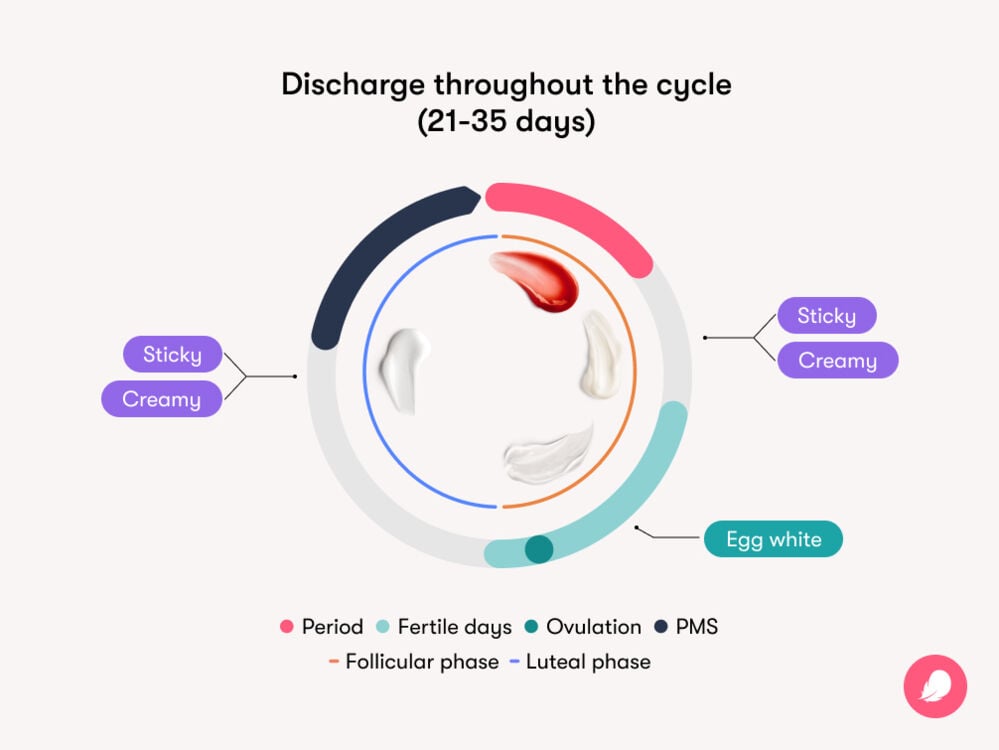Know why sticky discharge happens, how your discharge might change throughout your cycle, and how to spot issues that need a doctor’s attention.
-
Tracking cycle
-
Getting pregnant
-
Pregnancy
-
Help Center
-
Flo for Partners
-
Anonymous Mode
-
Flo app reviews
-
Flo Premium New
-
Secret Chats New
-
Symptom Checker New
-
Your cycle
-
Health 360°
-
Getting pregnant
-
Pregnancy
-
Being a mom
-
LGBTQ+
-
Quizzes
-
Ovulation calculator
-
hCG calculator
-
Pregnancy test calculator
-
Menstrual cycle calculator
-
Period calculator
-
Implantation calculator
-
Pregnancy weeks to months calculator
-
Pregnancy due date calculator
-
IVF and FET due date calculator
-
Due date calculator by ultrasound
-
Medical Affairs
-
Science & Research
-
Pass It On Project New
-
Privacy Portal
-
Press Center
-
Flo Accuracy
-
Careers
-
Contact Us
Sticky discharge: What does it mean?


Every piece of content at Flo Health adheres to the highest editorial standards for language, style, and medical accuracy. To learn what we do to deliver the best health and lifestyle insights to you, check out our content review principles.
Vaginal discharge is an umbrella term for fluids that come out of your vagina and your cervix (the tube-like muscle that connects your uterus to your vagina). Generally, it’s there to keep you clean and healthy, while also protecting you against infections. It’s a pretty wonderful thing.
It’s normal to notice around 0.5 to 1 tsp (2.5 to 5 ml) of discharge in your underwear every day, and you might notice that sometimes yours feels creamy, sticky, or wet, depending on which day you’re on in your cycle.
Alongside helping to keep your vulva clean, your discharge can also signal when something is up and may need attention from a health care professional.
So where does sticky discharge sit in all of this? Let’s talk about it with the help of Dr. Jenna Beckham, obstetrician, gynecologist, and family planning specialist, WakeMed Health and Hospitals, Planned Parenthood South Atlantic, North Carolina, US.
Key takeaways
- As a mixture of fluid, healthy bacteria, and mucus, discharge works to keep your vagina clean and lubricated, while also protecting you against infections. Clever, right?
- Healthy vaginal discharge varies in consistency and quantity throughout your menstrual cycle. It’s hard to tell if your discharge is normal purely through texture alone, but if the sticky discharge you’re seeing is whitish or clear and mildly odored, it’s likely A-OK.
- Sexual arousal, pregnancy, menstruation, and infections can also affect your vaginal discharge and could contribute to feelings of “stickiness.”
- If you’re worried that something isn’t quite right, some of the biggest telltale signs of an infection include discharge that is foul smelling, clumpy like cottage cheese, green or yellow, or accompanied by uncomfortable symptoms like pain, itchiness, or sores. If you notice any of these — or other unusual changes in your discharge — you should flag it with a health care professional.
Is sticky vaginal discharge normal?
Normal vaginal discharge varies in consistency and quantity due to hormonal shifts throughout the menstrual cycle. “It can also be different from person to person,” Dr. Beckham points out, “and even from one cycle to the next.”
So let’s dig into what exactly happens during your cycle. Your cycle is split into two phases: the follicular phase and the luteal phase. In between these two phases is ovulation, the point in your cycle when one of your ovaries releases an egg to be potentially fertilized by a sperm.
Take a quiz
Find out what you can do with our Health Assistant
Ovulation, your period, and the different phases of your cycle are all driven by the rise and fall of your sex hormones like estrogen and progesterone. Estrogen plays an important role in supporting you as you have your period and potentially prepare for pregnancy and can impact the way your discharge looks and feels.
If your discharge feels sticky, then this isn’t generally anything to worry about. But, “It can be difficult to distinguish normal versus abnormal discharge by the texture alone,” Dr. Beckham says. “So, generally, it’s important to pay attention to other symptoms like pain, bleeding, or change in the color or odor of discharge.”
More on abnormal discharge later. But as a general rule, if the sticky discharge you’re noticing is whitish or clear and isn’t accompanied by a foul vaginal odor (or other bothersome vaginal symptoms like itchiness or pain), it’s likely just your body keeping you healthy and comfortable.
What is sticky discharge for?
Vaginal discharge “is a sign of normal hormonal balance and a way for the cells of the vagina to ‘refresh’ themselves,” says Dr. Beckham. It keeps the vagina clean, healthy, and lubricated, while also protecting you against infections.
“Discharge is often stickier shortly after your period and again after ovulation,” she continues. “The stickier discharge makes it harder for sperm to penetrate, so it usually gets like this when you’re in a less fertile period.”
That’s in contrast to “fertile” discharge, which you might notice around ovulation. It’s clear and stretchy — similar to the consistency of raw egg whites — and is your body’s way of making it easier for sperm to swim up the vagina and meet an egg in your fallopian tube.
All of this is totally normal. But if you want to keep an eye on changes in your vaginal discharge and better understand its patterns, you can make a habit of logging it in a period-tracking app like Flo.
What else can cause sticky discharge?
Arousal
“Many people notice an increase in discharge when sexually aroused,” Dr. Beckham says. When you feel turned on, your vagina will often lubricate itself with a wet, slippery fluid. This is in anticipation of sex, to reduce friction and make things more comfortable.
The composition and amount of “arousal fluid” you might see can vary. If you’re wondering whether what you’re feeling is discharge or arousal fluid, the latter is typically clear, thin, and, like we said, decidedly slippery. But both might contribute to feelings of “stickiness.”
Menstruation
As you approach your period or just after you finish it, you may notice vaginal discharge that is tinged with pink, red, or brown. This is just discharge mixed with a bit of period blood, and it may be sticky. But it isn’t usually anything to worry about. This discharge isn’t actually caused by your period. It’s simply the discharge your body naturally produces at this point in your cycle.

Infection
While sticky discharge is usually totally healthy, it’s worth being in the know about certain infections that can change the way your discharge looks and smells. That way you can identify normal versus abnormal discharge.
- Trichomoniasis: This sexually transmitted infection (STI) can cause abnormal discharge that is thick, thin, or frothy and yellow-green. You might notice that you’re producing more discharge than normal. It may have a fishy smell, and you may have soreness, swelling, and itching around the vulva, too.
- Chlamydia: This STI can cause a pus-like vaginal discharge. Other symptoms of chlamydia include pain when you pee, pain during sex, and bleeding after sex or between your periods. However, many people with chlamydia don’t have any symptoms at all.
- Yeast infection: This vaginal infection can cause a thick, white, clumpy vaginal discharge. It’s less sticky than it is curd-like (think cottage cheese). Yeast infections are usually accompanied by itching and burning around the skin of the vulva.
- Bacterial vaginosis: This infection is caused by an imbalance of bacteria in your vagina. Bacterial vaginosis commonly causes an unusual white or gray discharge that has a strong, fishy smell.
When to see a doctor about sticky discharge
It’s a good idea to keep an eye out for any types of vaginal discharge that aren’t normal for you. Some of the biggest telltale signs of an infection, Dr. Beckham says, are a “change in the volume, color, or odor of vaginal discharge; itching, burning, irritation, redness, pain with sex, or even pain with urination.”
So if you notice any of this, it’s time to flag it with a health care professional. If you do have an infection, medication can usually clear it up.
More frequently asked questions about sticky discharge
Is sticky discharge a sign of pregnancy?
Discharge naturally shifts in consistency and quantity throughout your cycle. Sticky discharge is usually totally normal within this. However, if you’re noticing increased vaginal discharge alongside a no-show period — or other potential early pregnancy symptoms — you should take a pregnancy test.
What does glue-like discharge mean?
To answer this question clearly, it really depends on what we mean by glue-like. If your discharge is clear and stretchy, then it may mean you’ve recently ovulated. After ovulation, your discharge might become thick and white, and there might be more of it. White, sticky discharge can be normal throughout your cycle.
Does sticky discharge mean your period is coming?
A thick, white, sticky discharge could mean you’re nearing the end of your cycle and that your period is around the corner. But sticky discharge can happen throughout your cycle. Tracking your period and being mindful of other signs that your period is coming — like mood swings, bloating, and sore boobs — may give you a better idea.


Hey, I'm Anique
I started using Flo app to track my period and ovulation because we wanted to have a baby.


The Flo app helped me learn about my body and spot ovulation signs during our conception journey.


I vividly
remember the day
that we switched
Flo into
Pregnancy Mode — it was
such a special
moment.
Real stories, real results
Learn how the Flo app became an amazing cheerleader for us on our conception journey.
References
“Bacterial Vaginosis.” NHS, www.nhs.uk/conditions/bacterial-vaginosis/. Accessed 14 Oct. 2024.
“Brown Discharge: 4 Causes and What It Means.” Cleveland Clinic, 25 July 2022, health.clevelandclinic.org/brown-vaginal-discharge.
“Cervical Mucus.” Cleveland Clinic, my.clevelandclinic.org/health/body/21957-cervical-mucus. Accessed 14 Oct. 2024.
“Cervix.” Cleveland Clinic, my.clevelandclinic.org/health/body/23279-cervix. Accessed 14 Oct. 2024.
“Female Ejaculation Orgasm vs. Coital Incontinence: A Systematic Review.” The Journal of Sexual Medicine, vol. 10, no. 7, July 2013, pp. 1682–91, https://doi.org/10.1111/jsm.12166.
“Follicular Phase.” Cleveland Clinic, my.clevelandclinic.org/health/body/23953-follicular-phase. Accessed 14 Oct. 2024.
“Luteal Phase.” Cleveland Clinic, my.clevelandclinic.org/health/articles/24417-luteal-phase. Accessed 14 Oct. 2024.
“Sexual Response Cycle.” Cleveland Clinic, my.clevelandclinic.org/health/articles/9119-sexual-response-cycle. Accessed 14 Oct. 2024.
Sobel, Jack D. “Patient Education: Vaginal Discharge in Adult Women (Beyond the Basics).” UpToDate, 13 Mar. 2023, www.uptodate.com/contents/vaginal-discharge-in-adult-women-beyond-the-basics/print.
Spence, Des, and Catriona Melville. “Vaginal Discharge.” BMJ, vol. 335, no. 7630, Dec. 2007, pp. 1147–51.
“Symptoms: Chlamydia.” NHS, www.nhs.uk/conditions/chlamydia/symptoms/. Accessed 14 Oct. 2024.
Thiyagarajan, Dhanalakshmi K., et al. “Physiology, Menstrual Cycle.” StatPearls, StatPearls Publishing, 24 Sep. 2024, www.ncbi.nlm.nih.gov/books/NBK500020/.
“Trichomoniasis.” Mayo Clinic, 17 May 2022, www.mayoclinic.org/diseases-conditions/trichomoniasis/symptoms-causes/syc-20378609.
“Vaginal Discharge.” Cleveland Clinic, my.clevelandclinic.org/health/symptoms/4719-vaginal-discharge. Accessed 14 Oct. 2024.
“Vaginal Discharge.” NHS, www.nhs.uk/conditions/vaginal-discharge/. Accessed 14 Oct. 2024.
“Vaginal Discharge.” NHS Inform, 1 June 2023, www.nhsinform.scot/illnesses-and-conditions/sexual-and-reproductive/vaginal-discharge/.
“Vaginal Discharge in Pregnancy.” NHS, 18 Apr. 2024, www.nhs.uk/pregnancy/related-conditions/common-symptoms/vaginal-discharge/.
“Vaginitis.” Mayo Clinic, 22 Dec. 2021, www.mayoclinic.org/diseases-conditions/vaginitis/symptoms-causes/syc-20354707.
“Vulvovaginal Health.” The American College of Obstetricians and Gynecologists, Feb. 2020, www.acog.org/womens-health/faqs/vulvovaginal-health.
“Vaginal Yeast Infection.” Cleveland Clinic, my.clevelandclinic.org/health/diseases/5019-vaginal-yeast-infection. Accessed 14 Oct. 2024.
“What Ovulation Signs Can I Watch For if I Want to Get Pregnant?” Mayo Clinic, 9 July 2024, www.mayoclinic.org/healthy-lifestyle/getting-pregnant/expert-answers/ovulation-signs/faq-20058000.




